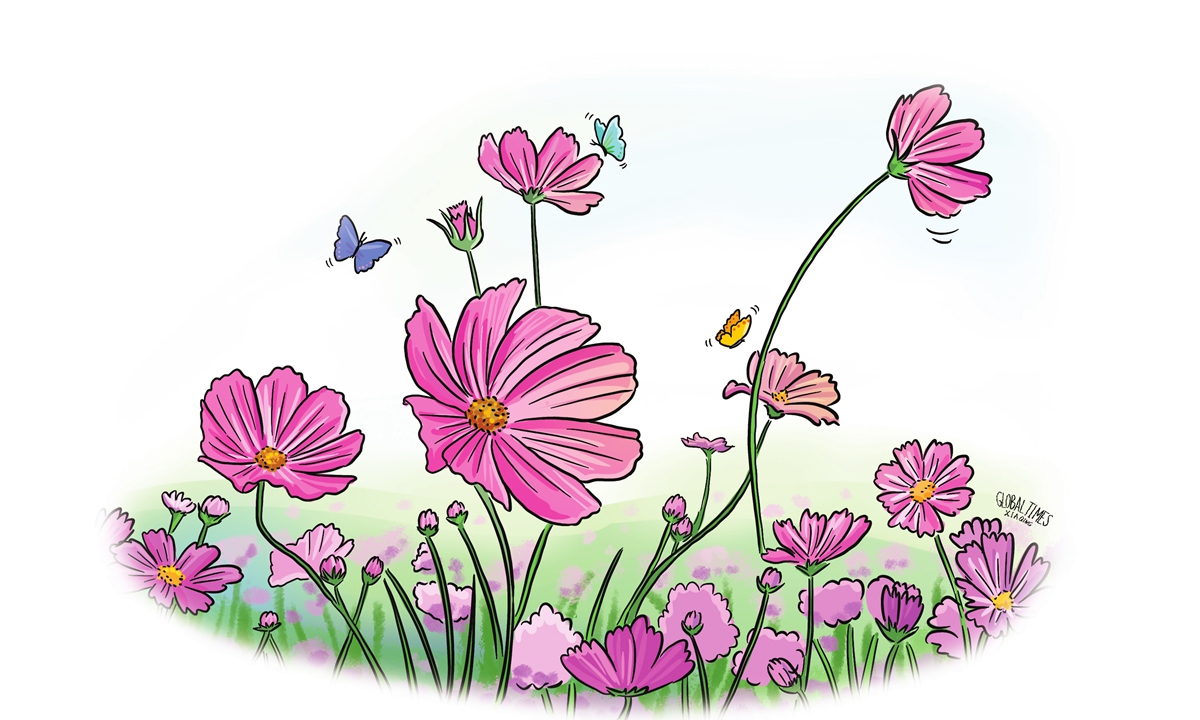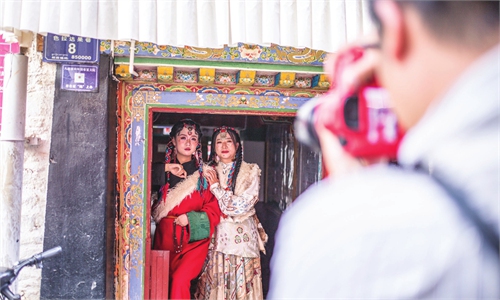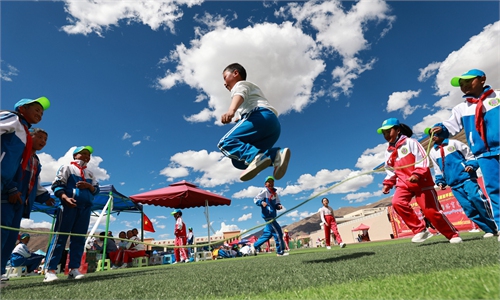
Illustration: Xia Qing/GT
President Xi Jinping pointed out in his congratulatory letter to the "2023 Forum on the Development of Xizang, China" that "People's happiness is the ultimate human right, while development holds the key to delivering better lives to the people." Looking back at the earth-shaking changes in the region over the past 70-plus years since Xizang's peaceful liberation, it can be said that the Communist Party of China (CPC) has led the people of all ethnic groups in Xizang to create a miracle of human survival and development on "the roof of the world," which is also a miracle in the history of human rights in the world.In 1992, I happened to visit Banjue Lunbu Village, located about 5 kilometers southwest of Gyantse county in Xizang. Standing on the roof of Pala Manor, I saw the new Tibetan-style buildings. They stood two or three stories high, and had already overwhelmed the once towering Pala Manor. Suddenly, I felt that this was a rare social specimen that could represent the past, present and future of Xizang. So I began a tracking investigation of Pala Village which lasted more than 10 years and published several books. Even today, I still maintain close contact with the villagers.
Pala Manor is the ancestral manor of the prominent aristocratic Pala family in old Xizang. After intense historical changes, Pala Manor became the only well-preserved feudal lord manor in Xizang. In 1994, the Government of the Xizang Autonomous Region designated it as a patriotic education base. And in 1996, it was included in the autonomous region-level cultural relic protection unit. In 2013, it was listed as the seventh batch of national key protected cultural relic units. It has become a famous tourist attraction in Gyantse county and even in Xizang.
As the "symbol" of the Pala family, Pala Manor once stood out on the Gyantse Plain, and magnificent Dajingtang, a kind of Tibetan flat roof building, was particularly famous. The manor is a circular building comprising 82 rooms on three floors, with a total area of over 5,000 square meters, with a large garden behind it. In front of it are three dark and low "Langsheng (home slave) Courtyards", of which only the largest one has been preserved. It has an area of less than 150 square meters, and it used to accommodate more than 60 serfs from 14 households. Each room is only about 10 square meters. The Langsheng family would sleep on a mud platform. The rooms where they slept were small and dark, and they lived a most basic and impoverished life. Someone without a family did not even have the right to housing and could only live in a cowshed or a horse stable. The per capita living area of the serfs was less than 2.5 square meters.
The word "Langsheng" refers to a serf who served the needs of the lord their whole life. For the able-bodied Langsheng, the lord would provide 16 Ruke (1 Ruke is equal to about 8 to 9 kilograms) of grain and 1 roll of inferior Pulu, a kind of woolen fabric handmade by the Tibetan people, to make clothes as income for the whole year, which had to support the entire family. They relied on thin soup and porridge to meet their basic physiological needs. For them, mixed peas and coarse cornmeal was a luxury. I conducted detailed questionnaire surveys for each family and calculated that the annual per capita grain consumption of serf households at that time was less than 100 kilograms. I then understood the meaning of the saying, "We didn't grow up eating zanba (a special Tibetan food, which means chow mein), we grew up hungry."
The distinction between serfs and livestock lies solely in their ability to speak, with the lord having the arbitrary power to punish and dispose of them as he wishes. Once displeased, The lord of Pala Manor Wangjiu often takes his frustrations out on the serfs, resorting to physical violence, leaving many injured and maimed. In the harsh winter, he would heartlessly throw the blacksmith's son into the ditch for amusement, claiming to "cleanse his dark bones." Serfs had no freedom in marriage and the owner would choose a mate for them within the estate. Female serfs, burdened with childbirth, struggle to rise from their beds and were forced to make up for lost work hours. Langsheng often lack the right to marry and build a family, ending up lonely and aging in solitude. Endless "Wula" corvée, day and night toil, insurmountable debts, and the inescapable status of hereditary serfdom inflict perpetual suffering on the serfs year after year.
In the past, the Banjue Lunbu Village, along with the entire rural Xizang, depended largely on the whims of nature. People on the high plateau struggled through frequent natural disasters, relying on the blessings of the Buddha and the spells of the sorcerer. Grain yields were meager, averaging only 50 kilograms per mu. The Pala Manor's total grain production was less than 30,000 kilograms. After the democratic reforms, productivity continued to rise, and Gyantse once set the record for the highest wheat yield in Xizang. Currently, the village has 1,767 acres of arable land, used mainly for growing highland barley, wheat, rapeseed, potatoes and peas. In 2022, the total grain production approached 900,000 kilograms, with an average yield of 502 kilograms per mu. Not only did the grain yield per mu increase tenfold, but all three industries developed comprehensively, establishing grain and oil processing plants and agricultural machinery professional cooperatives. The village's collective economy, primarily based on the first industry, generated a total income of 3.54 million yuan; the second industry, mainly industrial and construction, brought in 4.51 million yuan; and the third industry, covering transportation, catering, and services, earned 4.41 million yuan. In 2022, the per capita income of the entire village was 18,908.42 yuan.
Today, illiteracy and poverty have been virtually eradicated in Banjue Lunbu Village, with 134 students currently enrolled, including 9 university students, 14 high school students, 18 junior high school students, 63 primary school students, and 30 preschool children. Almost one member of every household has gone to university.
Since the new era, Banjue Lunbu Village has accelerated its development pace, and the people's sense of gain and happiness has continuously improved. The village now has access to high-voltage electricity, asphalt roads and tap water. It has full coverage of radio, television and communication networks. Cultural activity rooms and libraries have been established, as well as various sports and fitness equipment and facilities. Every household owns modern appliances and furniture, and large agricultural machinery and private cars can be seen everywhere. The blacksmith's family was once discriminated against. However, after marrying into a family from east China's Anhui Province, they opened a "Tibetans and Han are one family" store. Domestic and foreign tourists shuttle around, experiencing firsthand the changes in the lives of Tibetan farmers. In 2007, Banjue Lunbu Village was selected as an advanced village in the construction of civilization in Gyantse county, and it has maintained and upheld this honor for more than ten years. The village collectively allocates 100,000 yuan each year for cultural and spiritual civilization construction, and 10,000 yuan is allocated annually for hosting the Summer Cultural Festival.
The Deji family, who served as my landlord and translator during my investigation in the village, is a great example of the vivid changes in Langsheng Village. Deji's father, Nima Dunzhu, used to be a Langsheng who raised cows in Pala Manor before the democratic reform. He lived with his wife, children and aunt in a 12.6 square-meter Langsheng hut. After the reform and opening up, Nima Dunzhu was the first to build a two-story, 570 square meters Tibetan-style building in the village. His children successively found jobs. Deji, as the youngest daughter of Nima Dunzhu, now her son, after graduating from Hebei University of Technology, works in Lhasa and has also purchased a new house in Lhasa.
Over 70 years have passed, and the scenery of Pala Manor remains the same, but the people have changed.
Only by listening to the old Langsheng people's stories of their past hardships can one understand why "emancipated serfs sing proudly"; only by comparing the changes in human rights between the old and new Xizang can one understand why "the arrival of the Communist Party turns bitterness into sweetness." I will never forget their stories of sleeping in the fields and celebrating with songs and dances for three days and nights after they had received land. Nor will I forget their laughter when they talk about the development and prosperity of the village and family step by step. I often think of their worries: after the generation of old Langsheng has passed away like the wind, will people still know about Xizang's heavy past and cherish the hard-won present?
Pala Manor and Banjue Lunbu Village, where it is located, have always quietly existed in the plains at the foot of Gyantse Dzong. It is not the best-developed village in Xizang, but it is the village that best represents Xizang. I hope more people will come and visit, so that you can truly feel the pulse of Xizang's development and truly understand that the people's happiness is the greatest human right, and development is the key to achieving the people's happiness.
The author is a researcher at the Xi Jinping Thought on Socialism with Chinese Characteristics for a New Era Research Center in Beijing. opinion@globaltimes.com.cn


